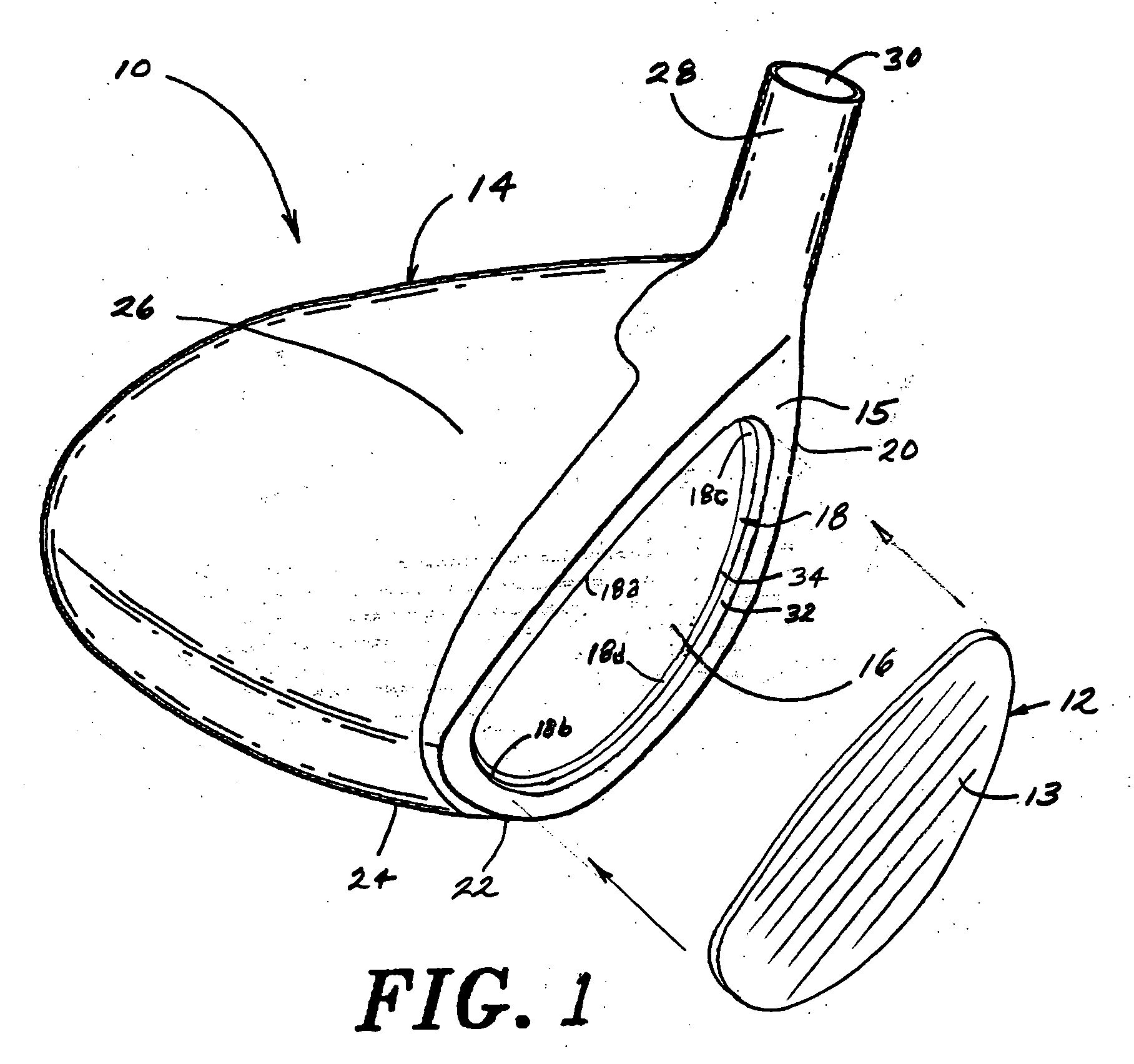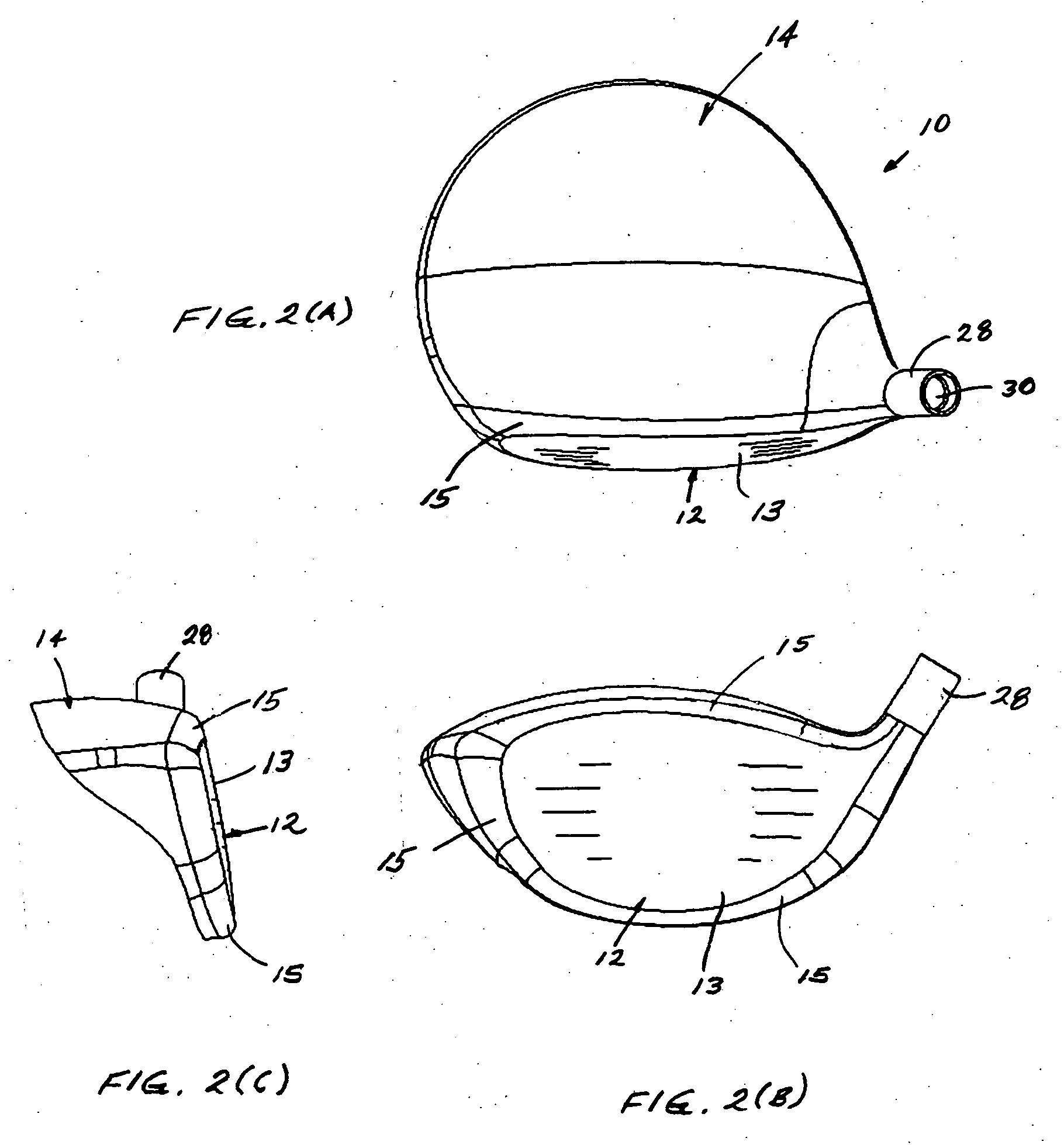Golf club-heads having a particular relationship of face area to face mass
a golf club and face mass technology, applied in golf clubs, golf, sport apparatus, etc., can solve the problems of rearward deflection of the face plate, limited cor of the club, and practicable limits to the maximum size of the club head
- Summary
- Abstract
- Description
- Claims
- Application Information
AI Technical Summary
Benefits of technology
Problems solved by technology
Method used
Image
Examples
example 1
[0070]In this example, a driver club-head was fabricated having a hollow titanium body (Ti-6Al-4V) and a composite face plate having a metal cap. The body is shown in FIGS. 12(A)-12(B), wherein FIG. 12(A) is a face normal (elevational) view and FIG. 12(B) is a section through a portion of the lip. Width and height dimensions (in mm) of the opening for the face plate are shown in FIG. 12(A), and representative lip dimensions (in mm) are shown in FIG. 12(B). The radius of the lip is generally in the range of 0.1 to 3.0 mm, more desirably in the range of 0.1 to 1.0 mm.
[0071]The composite portion of the face had a mass of 26.6 g, and comprised 70 g / m2 FAW carbon fiber material (34-700 carbon fiber; 34 Msi tensile modulus, 700 ksi ultimate tensile strength), and 40% R / C. Composite layup (front to back) was constant thickness: glass scrim +[Q]15+[90]+glass scrim, where Q=[90 / +45 / 0 / −45] from carbon fiber noted above, yielding a total of 61 plies.
[0072]The metal cap was made of 0.076 mm thi...
example 2
[0074]In this example, a driver club-head was fabricated having a hollow titanium body (Ti-6Al-4V) and a composite face plate having a metal cap. The body was the same as used in Example 1.
[0075]The composite portion of the face plate had a mass of 20.5 g, and comprised 150 g / m2 FAW carbon-fiber material (34-700 carbon fiber having 34 Msi tensile modulus and 700 ksi ultimate tensile strength), and 40% final R / C. Composite layup (front to back) was variable thickness: glass scrim +[Q]+[q+Q]4+[0 / 90]+glass scrim, where Q=[90 / +45 / 0 / −45], full face size, from carbon fiber noted above. Referring to FIG. 13, the composite portion 110 of the face plate 12 was 22 plies thick (carbon fiber) at the edges 112, and 38 plies thick (carbon fiber) at face center 113. Where q=[90 / +45 / 0 / −45], shapes smaller than the face are positioned near “face center.” The resulting “interlaminar plies” create the variable thickness of the face 12 plate shown in FIG. 13.
[0076]The metal cap 114 of the face plate 12...
example 3
[0077]In this example, a driver club-head was fabricated having a hollow titanium body (Ti-6Al-4V) and a composite face plate having a metal cap. The body is shown in FIGS. 14(A)-14(B), wherein FIG. 14(A) is a face normal (elevational) view and FIG. 14(B) is a section through a portion of the lip. Width and height dimensions of the opening for the face plate are shown in FIG. 14(A), and representative lip dimensions are shown in FIG. 14(B).
[0078]The composite portion of the face plate had a mass of 22.6 g, and comprised 70 g / m2 FAW carbon-fiber material (34-700 carbon fiber having 34 Msi tensile modulus and 700 ksi ultimate tensile strength), and 40% final R / C. Composite layup (front to back) was variable thickness: glass scrim +[Q]2+[q+Q]8+[Q]+[90]+glass scrim, where Q=[90 / +45 / 0 / −45], full face size, from carbon fiber noted above. The composite portion was 45 plies thick (carbon fiber) at face edges, and 77 plies thick (carbon fiber) at face center. Where q=[90 / +45 / 0 / −45], shapes s...
PUM
 Login to View More
Login to View More Abstract
Description
Claims
Application Information
 Login to View More
Login to View More - R&D
- Intellectual Property
- Life Sciences
- Materials
- Tech Scout
- Unparalleled Data Quality
- Higher Quality Content
- 60% Fewer Hallucinations
Browse by: Latest US Patents, China's latest patents, Technical Efficacy Thesaurus, Application Domain, Technology Topic, Popular Technical Reports.
© 2025 PatSnap. All rights reserved.Legal|Privacy policy|Modern Slavery Act Transparency Statement|Sitemap|About US| Contact US: help@patsnap.com



